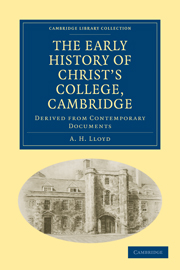Book contents
- Frontmatter
- Preface
- Contents
- LIST OF ILLUSTRATIONS
- List of Abbreviations
- Chronological Summary
- Dedication
- Chapter I William Byngham, the First Founder
- Chapter II The Dispute with John Langton
- Chapter III The First Royal Licence, 1439
- Chapter IV The Expansion of the Milne Street Site
- Chapter V The Royal Licences of 1442
- Chapter VI Marking Time: 1443 to 1446
- Chapter VII The Royal Licence of 1446 and its period
- Chapter VIII The Foundation Charter of the College of Godshouse and its period
- Chapter IX The Relationship of Godshouse and Clare Hall
- Chapter X The Last Days of William Byngham
- Chapter XI The Proctorship of John Hurte, 1451–1458, and of William Fallan, 1458–1464
- Chapter XII The Proctorship of William Basset, 1464–1477
- Chapter XIII The Proctorship of Ralph Barton, 1477–1490
- Chapter XIV The Proctorship of John Syclyng: Early Years, 1490–1496
- Chapter XV The Proctorship of John Syclyng: Later Years, 1496–1506
- Chapter XVI The Negotiations between Godshouse and the Lady Margaret
- Chapter XVII Syclyng's Death and Will
- Chapter XVIII The Buildings and Furniture remaining from the Godshouse period
- Chapter XIX Godshouse and Christ's College
- Appendix
- Index
- Plate section
Chapter IX - The Relationship of Godshouse and Clare Hall
Published online by Cambridge University Press: 05 October 2010
- Frontmatter
- Preface
- Contents
- LIST OF ILLUSTRATIONS
- List of Abbreviations
- Chronological Summary
- Dedication
- Chapter I William Byngham, the First Founder
- Chapter II The Dispute with John Langton
- Chapter III The First Royal Licence, 1439
- Chapter IV The Expansion of the Milne Street Site
- Chapter V The Royal Licences of 1442
- Chapter VI Marking Time: 1443 to 1446
- Chapter VII The Royal Licence of 1446 and its period
- Chapter VIII The Foundation Charter of the College of Godshouse and its period
- Chapter IX The Relationship of Godshouse and Clare Hall
- Chapter X The Last Days of William Byngham
- Chapter XI The Proctorship of John Hurte, 1451–1458, and of William Fallan, 1458–1464
- Chapter XII The Proctorship of William Basset, 1464–1477
- Chapter XIII The Proctorship of Ralph Barton, 1477–1490
- Chapter XIV The Proctorship of John Syclyng: Early Years, 1490–1496
- Chapter XV The Proctorship of John Syclyng: Later Years, 1496–1506
- Chapter XVI The Negotiations between Godshouse and the Lady Margaret
- Chapter XVII Syclyng's Death and Will
- Chapter XVIII The Buildings and Furniture remaining from the Godshouse period
- Chapter XIX Godshouse and Christ's College
- Appendix
- Index
- Plate section
Summary
The foundation of the college by Henry VI in his own person removed the need to connect with Godshouse in the charter the names of any outside persons, whether those of the Master and fellows of Clare Hall or others. This seems to be a fitting point therefore at which to consider the meaning of their mention in the earlier licences, and to explain its true purpose in the hope of sweeping away the misconceptions with regard to it which, appearing first in the latter half of the eighteenth century, still maintain their hold to-day within the college itself, in Clare College, within the university and elsewhere generally. Intimate relationship did obtain between the two colleges, but its nature has been altogether misinterpreted. It is the purpose of this chapter to set free the letters patent from their glosses, and to produce newly discovered documentary evidence which will shew the facts to possess attractions wanting in the fictions.
The king's licence to Byngham of 13 July 1439 has no parallel in the history of the university, for it is a licence not only to give land, the buildings erected thereon, and an income for their maintenance and for the support of their inmates, but one by which Byngham is authorised
(a) to found a separate institution of a chaplain and twenty-four scholars, with statutes and ordinances and with possessions secured from the operation of the Statute of Mortmain, for the academical purpose of training schoolmasters and also to pray for the king and the other benefactors of the house and his and their ancestors and
[…]
- Type
- Chapter
- Information
- The Early History of Christ’s College, CambridgeDerived from Contemporary Documents, pp. 105 - 120Publisher: Cambridge University PressPrint publication year: 2010First published in: 1934



